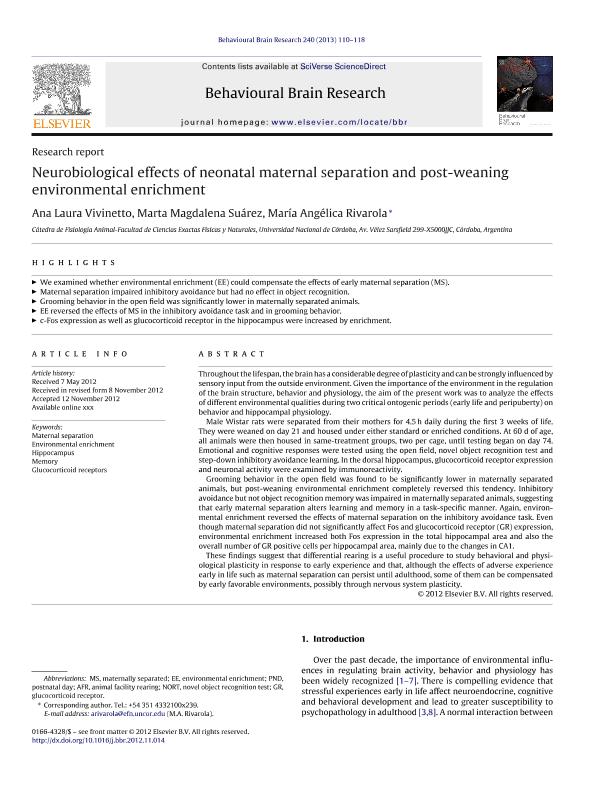Mostrar el registro sencillo del ítem
dc.contributor.author
Vivinetto, Ana Laura

dc.contributor.author
Suarez, Marta Magdalena

dc.contributor.author
Rivarola, María Angélica

dc.date.available
2019-06-24T13:45:26Z
dc.date.issued
2013-03
dc.identifier.citation
Vivinetto, Ana Laura; Suarez, Marta Magdalena; Rivarola, María Angélica; Neurobiological effects of neonatal maternal separation and post-weaning environmental enrichment; Elsevier Science; Behavioural Brain Research; 240; 1; 3-2013; 110-118
dc.identifier.issn
0166-4328
dc.identifier.uri
http://hdl.handle.net/11336/78693
dc.description.abstract
Throughout the lifespan, the brain has a considerable degree of plasticity and can be strongly influenced by sensory input from the outside environment. Given the importance of the environment in the regulation of the brain structure, behavior and physiology, the aim of the present work was to analyze the effects of different environmental qualities during two critical ontogenic periods (early life and peripuberty) on behavior and hippocampal physiology.Male Wistar rats were separated from their mothers for 4.5. h daily during the first 3 weeks of life. They were weaned on day 21 and housed under either standard or enriched conditions. At 60 d of age, all animals were then housed in same-treatment groups, two per cage, until testing began on day 74. Emotional and cognitive responses were tested using the open field, novel object recognition test and step-down inhibitory avoidance learning. In the dorsal hippocampus, glucocorticoid receptor expression and neuronal activity were examined by immunoreactivity.Grooming behavior in the open field was found to be significantly lower in maternally separated animals, but post-weaning environmental enrichment completely reversed this tendency. Inhibitory avoidance but not object recognition memory was impaired in maternally separated animals, suggesting that early maternal separation alters learning and memory in a task-specific manner. Again, environmental enrichment reversed the effects of maternal separation on the inhibitory avoidance task. Even though maternal separation did not significantly affect Fos and glucocorticoid receptor (GR) expression, environmental enrichment increased both Fos expression in the total hippocampal area and also the overall number of GR positive cells per hippocampal area, mainly due to the changes in CA1.These findings suggest that differential rearing is a useful procedure to study behavioral and physiological plasticity in response to early experience and that, although the effects of adverse experience early in life such as maternal separation can persist until adulthood, some of them can be compensated by early favorable environments, possibly through nervous system plasticity.
dc.format
application/pdf
dc.language.iso
eng
dc.publisher
Elsevier Science

dc.rights
info:eu-repo/semantics/openAccess
dc.rights.uri
https://creativecommons.org/licenses/by-nc-sa/2.5/ar/
dc.subject
Environmental Enrichment
dc.subject
Glucocorticoid Receptors
dc.subject
Hippocampus
dc.subject
Maternal Separation
dc.subject
Memory
dc.subject.classification
Otras Ciencias de la Salud

dc.subject.classification
Ciencias de la Salud

dc.subject.classification
CIENCIAS MÉDICAS Y DE LA SALUD

dc.title
Neurobiological effects of neonatal maternal separation and post-weaning environmental enrichment
dc.type
info:eu-repo/semantics/article
dc.type
info:ar-repo/semantics/artículo
dc.type
info:eu-repo/semantics/publishedVersion
dc.date.updated
2019-06-19T12:22:29Z
dc.journal.volume
240
dc.journal.number
1
dc.journal.pagination
110-118
dc.journal.pais
Países Bajos

dc.journal.ciudad
Amsterdam
dc.description.fil
Fil: Vivinetto, Ana Laura. Universidad Nacional de Córdoba. Facultad de Cs.exactas Físicas y Naturales. Departamento de Fisiología Animal; Argentina. Consejo Nacional de Investigaciones Científicas y Técnicas. Centro Científico Tecnológico Conicet - Córdoba. Instituto de Investigación Médica Mercedes y Martín Ferreyra. Universidad Nacional de Córdoba. Instituto de Investigación Médica Mercedes y Martín Ferreyra; Argentina
dc.description.fil
Fil: Suarez, Marta Magdalena. Universidad Nacional de Córdoba. Facultad de Cs.exactas Físicas y Naturales. Departamento de Fisiología Animal; Argentina
dc.description.fil
Fil: Rivarola, María Angélica. Universidad Nacional de Córdoba. Facultad de Cs.exactas Físicas y Naturales. Departamento de Fisiología Animal; Argentina. Consejo Nacional de Investigaciones Científicas y Técnicas. Centro Científico Tecnológico Conicet - Córdoba. Instituto de Investigaciones en Ciencias de la Salud. Universidad Nacional de Córdoba. Instituto de Investigaciones en Ciencias de la Salud; Argentina
dc.journal.title
Behavioural Brain Research

dc.relation.alternativeid
info:eu-repo/semantics/altIdentifier/url/https://www.ncbi.nlm.nih.gov/pubmed/23195113
dc.relation.alternativeid
info:eu-repo/semantics/altIdentifier/doi/http://dx.doi.org/10.1016/j.bbr.2012.11.014
Archivos asociados
